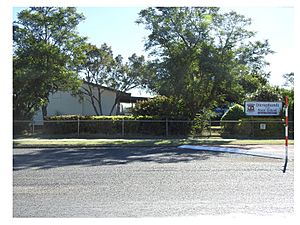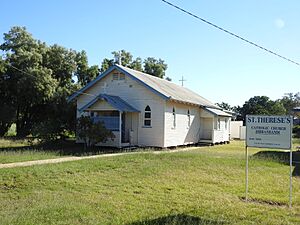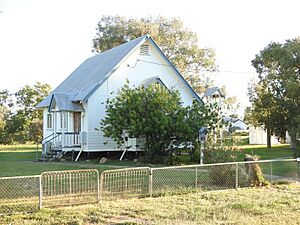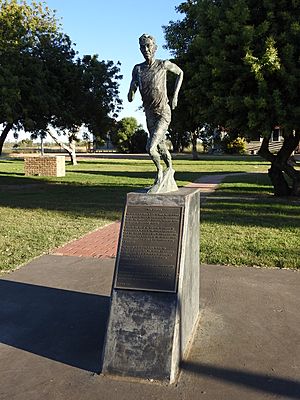Dirranbandi, Queensland facts for kids
Quick facts for kids DirranbandiQueensland |
|||||||||||||||
|---|---|---|---|---|---|---|---|---|---|---|---|---|---|---|---|
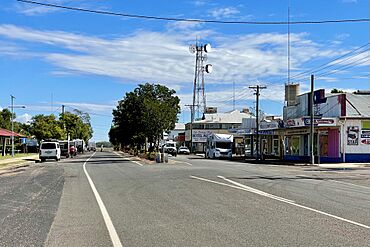
Railway Street (Castlereagh Highway) Dirranbandi, 2021
|
|||||||||||||||
| Population | 610 (2021 census) | ||||||||||||||
| • Density | 0.0739/km2 (0.191/sq mi) | ||||||||||||||
| Established | 1885 | ||||||||||||||
| Postcode(s) | 4486 | ||||||||||||||
| Elevation | 173 m (568 ft) | ||||||||||||||
| Area | 8,250.4 km2 (3,185.5 sq mi) | ||||||||||||||
| Time zone | AEST (UTC+10:00) | ||||||||||||||
| Location | |||||||||||||||
| LGA(s) | Balonne Shire | ||||||||||||||
| State electorate(s) | Warrego | ||||||||||||||
| Federal Division(s) | Maranoa | ||||||||||||||
|
|||||||||||||||
Dirranbandi is a rural town and locality in the Shire of Balonne, Queensland, Australia. It is located right on the border between Queensland and New South Wales. In 2021, about 610 people lived in Dirranbandi.
Contents
About Dirranbandi
Dirranbandi is on the Castlereagh Highway and the Balonne River. Many people come here to work on the large cotton farms. Because there isn't much rain, farmers use irrigation to water their crops. This means they bring water from rivers or underground to help plants grow.
History of Dirranbandi
Dirranbandi has a rich history connected to Aboriginal people. The land around Dirranbandi is home to the Gamilaraay and Yuwaalaraay language groups. These are important Aboriginal languages from this part of Australia.
How Dirranbandi Got Its Name
The town was first mapped out in 1885. It's believed the name "Dirranbandi" comes from an Aboriginal word. It might mean "broken forest country" or "chorus of frogs at night." Another idea is that it comes from Dhurrunbandaay, which relates to "hairy caterpillars" moving in a line.
Early Days and Growth
When the town was first planned, land was set aside for homes, a police station, a school, and a post office.
Dirranbandi Provisional School first opened in 1902. It closed for a short time but reopened in 1908. In 1909, it became Dirranbandi State School. Later, in 1963, it started offering secondary education up to Year 10.
The Railway Arrives
The railway reached Dirranbandi in 1913. This was a big deal for the town, helping to transport goods and people. The town had its own Dirranbandi railway station. Other small railway stations like Kundilam (later Bonathorne) and Noondoo were also nearby. The name Kundilam means "scrub berry" in an Aboriginal language.
Dirranbandi was the last place in Australia to have a special "mail train" service. This train carried mail to different towns. The railway line to Dirranbandi closed in 2010.
Community Buildings
The St. Therese's Catholic Church was officially opened in 1928. The St Mark's Anglican Church opened for services in 1935 and was officially dedicated in 1936.
Recent Events
The town has experienced serious floods in 2010 and 2011. During the COVID-19 pandemic in 2020 and 2021, the border crossing point near Dirranbandi was closed. This was to help keep people safe and stop the spread of the virus.
People in Dirranbandi
In 2021, Dirranbandi had a population of 610 people. Most people living here were born in Australia and speak English at home.
Education in Dirranbandi
Dirranbandi P-10 State School is a school for students from Prep (the year before Year 1) up to Year 10. It teaches both primary and secondary students.
For students who want to study Year 11 and 12, they can go to St George State High School in nearby St George. Other choices include distance education (learning from home) or going to a boarding school.
Facilities in Dirranbandi
Dirranbandi has many useful facilities for its residents. These include a hospital, a civic centre (for community events), a swimming pool, a park, and a showground.
The Balonne Shire Council runs a library located on the Castlereagh Highway. The Dirranbandi branch of the Queensland Country Women's Association (QCWA), a group that supports women and communities, has its rooms on Kirby Street.
You can find St Therese's Catholic Church on Kirby Street and St Mark's Anglican Church on Moore Street. The Dirranbandi Uniting Church also meets at the Anglican Church.
The Dirranbandi Aerodrome is a small airport at the end of Moore Street. It has a sealed runway with lights, which means planes can land and take off safely.
Famous People from Dirranbandi
- Tom Dancey (1888–1957) was a local stockman and an Indigenous Australian. In 1910, he won Australia's most famous footrace, the Stawell Gift. There's a statue of him in Dirranbandi.
- William Grant (1870–1939) was a Brigadier General who bought land in the area after World War I. He was involved in the Australian Light Horse, a famous group of soldiers on horseback. Artwork in Dirranbandi remembers the town's contribution of men and horses to the Light Horse.
- Ray Meagher is a well-known actor who grew up near Dirranbandi. He is famous for playing the character Alf Stewart in the TV show Home and Away. He even says that one of Alf's famous sayings, "Stone the flamin' crows!", came from a local person in Dirranbandi.
Gallery



